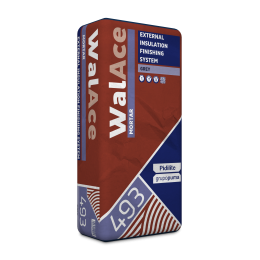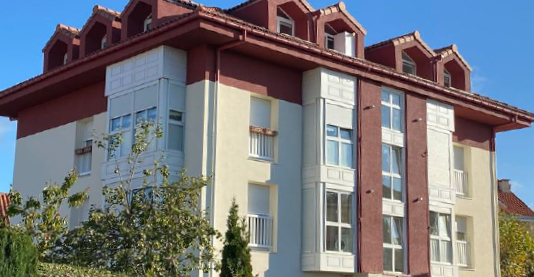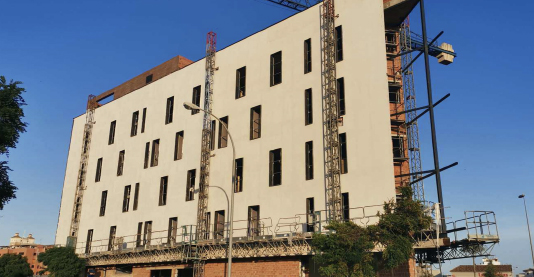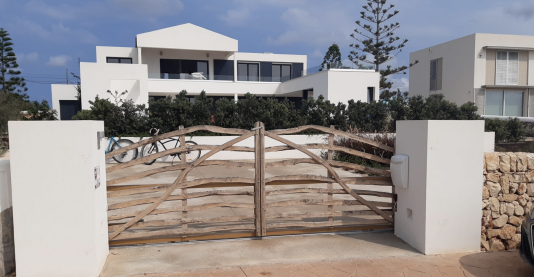 WalAce® Mortar GP W2
WalAce® Mortar GP W2

Hydraulic mortar used as an adhesive and covering on EPS or XPS or MW in the external heat insulation system WalAce EIFS. This mortar, ideal for exterior thermal insulation system, has great adhesion, waterproofing, easy application and does not spread the flame. It is permeable to water vapour.
Additional information
Advantages and Uses
- High adherence
- Waterproof
- Water vapor permeable
- Easy to apply
- Not combustible
Application Procedure
- Mix powder to water with help of a mechanical stirrer until a homogeneous paste is obtained. For 25kg bag water added must be within 4.5 – 5 l
- There are two ways to fix the boards to the substrate with WalAce MORTAR:
NOTCHED TROWEL METHOD
- Apply and comb WalAce onto the insulation board notched trowel. In this way an even distribution of the adhesive is obtained all over the board.
- Remove the excess WalAce MORTAR from the edges of the board (approximately 20 mm)
- This method is used with substrates that are planimetrically correct, i.e. when the substrate planimetry is < 5 mm, measured with a 2 m measuring tape.
MORTAR BEAD METHOD
- Beads of mortar are applied, separated 2 cm from the edge of the insulation board, parallel to them. Three mortar blobs are made inside the rectangle formed by the beads.With this method overlaps of between 0.5 cm and 1 cm can be corrected, measured with a 2 m measuring tape.
Use as coating of the panels
- After a minimum of 24 hours from the bonding of the insulating panels, the mechanical anchors are placed and the reinforcement profiles are installed in the corners, and the burrs and unevenness between the panels are eliminated by using a sandpaper.
- Spread a layer of WalAce MORTAR directly on the insulation panel (or on a previously reinforced surface) and then regularise the thickness with a No. 8 notched trowel
- Unfold the WalAce MESH strips, overlapping each other by at least 100 mm, from top to bottom and press them with a trowel into the grooves of the WalAce MORTAR until they are completely embedded in it. This layer must be at least 2 mm thick and the grid of the embedded mesh must be visible on the surface.
- Once this layer is slightly hardened and as soon as possible (normally the following day), a second layer of WalAce MORTAR 2 mm smooth but not trowelled mortar will be applied, finishing the coated surface.
- Once the reinforced layer of WalAce Mortar is sufficiently cured. Wait at least 48 hours before applying the UNOFIN Acrylic Basecoat acrylic primer by roller, brush or spray, and after it has completely dried, which requires at least 24 hours, the final finish can be made with any of the acrylic mortars in the WalAce range.
Recommendations
- Substrates (brick, plaster and concrete) must be clean and free of dust, oil, paint, loose particles, etc.).
- Substrates should be as flat as possible.
- Application by points/blobs or leveling is necessary if irregularities are larger than 1 cm.
- The boards should never overlay the expansion joints of the building.
- Only use the “notched trowel method” when fixing the boards of mineral wool and natural cork to the support.
- Protect the upper part of the façade to avoid any possible rain water penetration.
- Do not apply under 5ºC nor above 30ºC. In case of application above 30⁰C special care must be taken (consult with the technical department). Do not apply when there is a risk of frost, rain, strong wind or direct sunlight.
- Do not apply to areas where there is a possibility of stagnant water.
- In extreme weather conditions (strong winds or hot temperatures) drying may occur faster.
- In areas where the Traditerm system is susceptible to direct impacts, it is advisable to reinforce the surface of the boards with a double layer of WalAce MESH.
Packaging and Storage
25 kg plastic-lined paper bags.
Shelf life: 1 year in sealed original packaging, sheltered from weather conditions and humidity.
Technical data
(Statistical data obtained under standard conditions)
| Reaction to fire | A1 |
| Water absorption | W2 |
| Water vapour permeability | µ < 15 |
| Adherence on terrazzo concrete | ≥ 0,8 N/mm² rupture behaviour A/B |
| Adherence of adhesive mortar on polystyrene boards | ≥ 0.08 N/mm² rupture behavior C |
| Performance (Adhesive + Covering) | 8-10 Kg/m² |
| Pot life | Around 90 minutes in standard conditions (25⁰C/50%RH) |
| Essential characteristics | Performances | Harmonised technical specification |
| Reaction to fire | A1 | EN-998-1:2010 |
| Water absorption | W2 | |
| Diffusion coefficient of water vapour | μ ≤ 15 | |
| Thermal conductivity (λ10, dry) | 0.33 W/mK (tabulated value) | |
| Adhesive on concrete | ≥ 0.8 N/mm² failure A/B |
Legal Disclaimer
The instructions for use are given according to our tests and knowledge and do not imply any commitment by PIDILITE GRUPO PUMA nor free the consumer from the examination and verification of the products for their correct use. Claims must be accompanied by the original packaging to allow a proper traceability.
PIDILITE GRUPO PUMA is not responsible, in any case, for the application of its products or constructive solutions carried out by the application company or other parties involved in the process and / or execution of the work, limiting the responsibility of PIDILITE GRUPO PUMA exclusively to the damages directly attributable to the supplied products, individually or integrated in systems, due to failures in their manufacturing process.
In any case, the drafter of the work project, the technical management or the person responsible for the work, or collaterally the application company or other parties involved in the process and / or execution of the work, must ensure the suitability of the products addressing the characteristics of them, as well as the conditions, support and possible pathologies of the work in question.
The values obtained by PIDILITE GRUPO PUMA's products or its constructive solutions that, as the case may be, are determined by the EN standards or any other regulation that applies to it in each case refers exclusively to the conditions specifically stipulated in said regulation and that are referred to, among others, to certain characteristics of the support, humidity and temperature conditions, etc. without being them required in the tests obtained under different conditions, all in accordance with the relevant regulation.
PIDILITE GRUPO PUMA is not responsible, in any case, for the application of its products or constructive solutions carried out by the application company or other parties involved in the process and / or execution of the work, limiting the responsibility of PIDILITE GRUPO PUMA exclusively to the damages directly attributable to the supplied products, individually or integrated in systems, due to failures in their manufacturing process.
In any case, the drafter of the work project, the technical management or the person responsible for the work, or collaterally the application company or other parties involved in the process and / or execution of the work, must ensure the suitability of the products addressing the characteristics of them, as well as the conditions, support and possible pathologies of the work in question.
The values obtained by PIDILITE GRUPO PUMA's products or its constructive solutions that, as the case may be, are determined by the EN standards or any other regulation that applies to it in each case refers exclusively to the conditions specifically stipulated in said regulation and that are referred to, among others, to certain characteristics of the support, humidity and temperature conditions, etc. without being them required in the tests obtained under different conditions, all in accordance with the relevant regulation.





